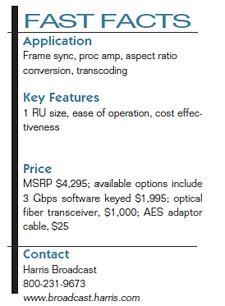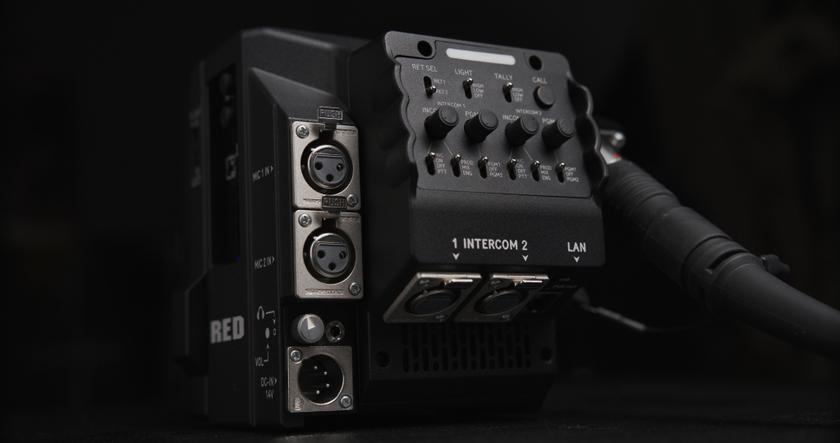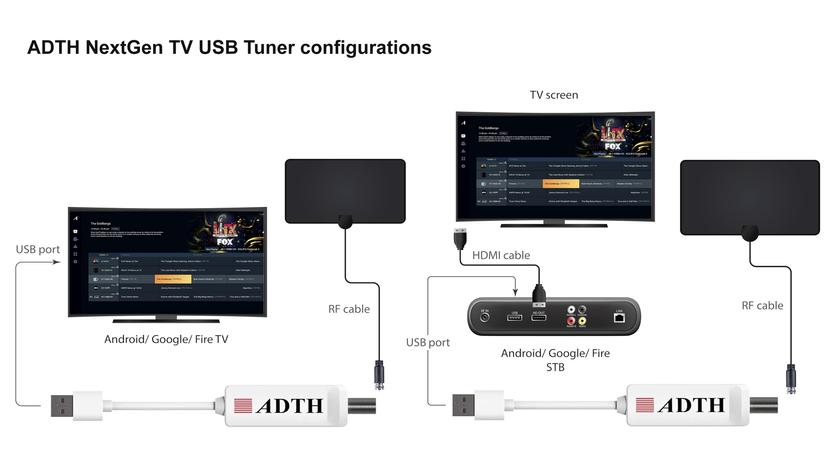Harris X50 Frame Synchronizer, Converter
I guess it's true—the more things change, the more they stay the same. Years ago in the analog world, if video arrived at your facility in less than "pristine" condition, the first thing to try would be running it through a frame sync. Of course, from an engineering standpoint, we knew beforehand if that "magic box" would help or not. For those less enlightened, the event was almost like Christmas if it improved the video.
While the world of DTV has raised the bar on video content, there are still times when signals need to be timed, and/or adjusted in the digital plant. For such occasions, products such as the new Harris X50 are more than up to that challenge.

The Harris X50 frame synchronizer/converterFEATURES
The 1RU X50 tips the scales at slightly more than eight pounds. It operates at 100 to 240 VAC, draws about 75 Watts, and has an operating temperature range between 41 and 95 degrees F.
Its feature set is large, including frame sync/delay, proc amp, noise reduction, clipping, color correction, motion detection, up/down/cross/aspect ratio conversion and more. The two aspect ratio converters provide full control over H/V size and position, along with audio embedding/de-embedding, sync, gain, inversion and delay, and also 16 channels of audio processing. It also passes Dolby Digital and Dolby E.
Video interfaces include analog composite and component. As mentioned, there are two SDI channels and these feature auto-sensing for .27/1.5 Gbps, sampled video, with 3G being an option. EDH/CRC error monitoring and insertion are included and there's an HDMI output for video and audio.
Audio interfaces include eight channels of analog, four channels of unbalanced AES, and four groups of embedded.
The X50 is compatible with both 608 and 708 closed captioning, along with Teletext and embedded audio metadata. AFD/widescreen signaling is also supported. Ethernet connectivity is available for control and monitoring, along with SNMP. There's a built-in Web server, and a local control panel as well. The X50 is compliant with both X85/75 and Nucleus control panels and CCS Navigator software. For manual control there are four GPI inputs and outputs. Test signals haven't been neglected either, as there are built-in generators for audio and video. Two power supplies are included for extra reliability. Options include optical fiber I/O and the aforementioned 3 Gbps connectivity.
The front of the unit sports an SD memory card slot and five status LEDs. There's also an LCD panel for status and menu selection, with an adjacent "roller" knob and pushbutton select system. There are also other operational controls, as well as 18 small LEDs to flag "alert" situations such as field rates, AFD, Dolby, test pattern and the like.
Signal interfaces are on the rear and include power, reference loop-through, various flavors of video inputs, including that delivered via fiber (optional).
IN USE
Once the X50 was unpacked, my first order of business was to power it up. The display came up with the familiar Harris logo, and after about 10 seconds the main menu was displayed, showing "Video, Audio and Reference." By scrolling down with the unit's roller knob, I found a number of other useful system setup selections, including input video choices, output formats, and audio choices.
I next connected SMPTE 292 1080i video from two HD studio cameras to SDI inputs 1 and 2. The X50's SDI outputs were connected to a router that feeds an HD monitoring station in our tech core. I had to remind myself that although there are two SDI I/O channels, the unit is a single-channel box. The camera one video appeared on both SDI outputs and when I removed the SDI 1 input, the outputs reverted to the second input source.
Moving on, I decided it was time to frame sync/proc/and/or ARC the heck out of something. I scrolled down to "Video" and pressed the "Enter" button. This revealed a list of several choices including "Proc, Color Corrector, Frame Sync, Analog Video, Test Signal, ARC 1, ARC 2," and more. I chose "Proc" and was offered further choices including "Black Level" and "Luma Gain."
I selected Luma Gain and the display turned into a "slider knob," with ±6 dB of adjustment. When I tried the "slider" my initial reaction was that the adjustment was a bit on the coarse side. (Interestingly, the word "coarse" appeared in the upper right portion of the display.) I found that when I "clicked" the roller knob, the adjustment became fine, and the display text changed to "fine." I then selected the frame sync functionality, allowing me to "Force Freeze" the picture. I stopped my evaluation here, as other duties called.
A couple of days later, I made it back to the X50 for more exploration. After hooking up the cables, a picture appeared instantly, but after playing with the controls for a few minutes, I noticed that the wrong news anchor was on the screen and that the picture was frozen. Apparently, I'd neglected to hook up the input cable and I was viewing the image from the previous session. It still looked good.

After connecting the SDI input to some fresh video, I scrolled the menu over to "Scaler 1" and explored several of the settings found there. There are presets for anamorphic, 4:3 pillar box, 16:9 pillar box, and more. There's also a custom setting to allow manual dimension entry, with an aspect ratio lock feature. For filling out pillar box spaces, there's a choice of black, red, green, orange, and grey at several selectable intensities.
Other menu items included a system setup, which revealed the unit's version, serial number, license info, fan status and IP information. By pressing and holding the status button, I was able to bring up the alarm menu, with alarms for missing video and/or audio, muting, missing AFD, core overheating, fan failure and more.
My next evaluation was IP connectivity. I'll admit to calling the folks at Harris in connection with this, as I didn't initially realize it was as simple as connecting a CAT-5 cable to my laptop from the X50 and then typing the IP address into the Firefox browser. Connectivity was a snap, and the menu tree is basic, but powerful. All of the same menu items available on the front panel are available via browser-based control. During the next week or so, I powered down the laptop and X50, trying to make IP connectivity difficult. I could not; it was rock solid.
SUMMARY
I honestly expected the browser-based control to be easier than the single knob menu control on the front panel. However, I found them both easy to operate, with a learning curve of zero (if you're familiar with the toolsets involved). The broadcaster in me would like to see some filtering on the chassis ventilation system; however, that's about the only thing I can suggest to make the X50 better than it already is. In true Harris form, with promised free code updates, the X50 you buy this year is likely to be seeing several decades of decades.
Joey Gill is chief engineer at television station WPSD in Paducah, Ky. He has been with the station for 25 years and has worked in broadcasting since 1977. He may be contacted atrespond2jgill@yahoo.com.
Get the TV Tech Newsletter
The professional video industry's #1 source for news, trends and product and tech information. Sign up below.













